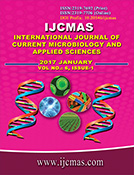


 National Academy of Agricultural Sciences (NAAS)
National Academy of Agricultural Sciences (NAAS)

|
PRINT ISSN : 2319-7692
Online ISSN : 2319-7706 Issues : 12 per year Publisher : Excellent Publishers Email : editorijcmas@gmail.com / submit@ijcmas.com Editor-in-chief: Dr.M.Prakash Index Copernicus ICV 2018: 95.39 NAAS RATING 2020: 5.38 |
The infection of diabetic foot ulcer is a debilitating complication of long standing diabetes especially with resistant bacteria. The production of extended spectrum beta-lactamase (ESBL) by gram negative bacteria is widely prevalent. This study was carried out to identify the prevalence, antimicrobial resistant pattern, ESBL production and the presence of TEM and SHV genes among ESBL producing Escherichia Coli. A total of 173 isolates were identified from 100 diabetic patients averaging 1.73 isolates per patient. Out of 173 isolates, 118 (68%) were gram negative bacilli and 55 (32%) were gram positive cocci and 38 were E.coli isolates (21.96%). The ESBL confirmatory test has found 18 (47.37%) (ESBL) producing strains of E.coli. The genotypic characterization of 18 ESBL producing E.Coli isolates by PCR has found that 12 (66.67%) isolates had TEM, one (5.56%) had SHV and one (5.56%) had both TEM and SHV genes. The molecular microbiological techniques can rapidly identify pathogens, the resistant genes and virulence factors. The culture method often underestimates the microbial load, diversity and the prevalence of fastidious and anaerobic bacteria. Treatment by multidisciplinary team with appropriate antibiotics, surgical debridement and proper wound care helps to improve outcome in infected diabetic foot ulcer.
 |
 |
 |
 |
 |